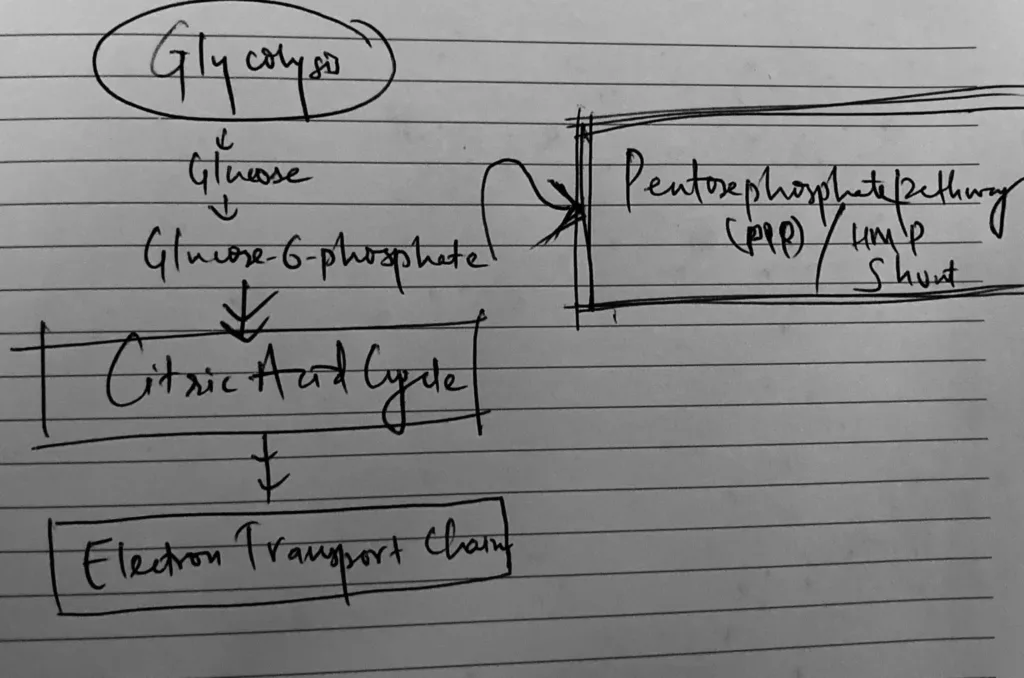The pentose phosphate pathway (PPP), also referred to as the hexose monophosphate shunt, is a metabolic mechanism that takes place in the cytosol of cells, where glycolysis also occurs.
- It is an alternative option to glycolysis for the breakdown of glucose and is required for the generation of cellular energy and the biosynthesis of essential cellular components.

The PPP (HMP shunt) makes two key end-products:
NADPH and Ribose-5-phosphate.
- NADPH is a reducing agent that is required for numerous metabolic activities in cells, including fatty acid and steroid production and reactive oxygen species detoxification.
- Ribose-5-phosphate is a precursor for the nucleotide synthesis, which are required for DNA and RNA synthesis.
Steps of Pentose Phosphate Pathway
The PPP consists of two phases: the oxidative phase and the non-oxidative phase.
- In the oxidative phase, glucose-6-phosphate is converted to ribulose-5-phosphate, and NADPH is produced.
- In the non-oxidative phase, the intermediates of the oxidative phase are rearranged to produce more ribose-5-phosphate or to enter back into glycolysis or gluconeogenesis.
The overall reaction of the PPP is as follows:
Glucose-6-phosphate + 2 NADP+ + H2O → Ribulose-5-phosphate + CO2 + 2 NADPH + 2 H+
Reaction of HMP shunt
Oxidative Phase
a. Glucose-6-phosphate is converted to 6-phosphogluconolactone by glucose-6-phosphate dehydrogenase (G6PDH).
b. 6-phosphogluconolactone is then converted to 6-phosphogluconate by lactonase.
c. 6-phosphogluconate is further oxidized by 6-phosphogluconate dehydrogenase (6PGDH) to generate ribulose-5-phosphate, carbon dioxide (CO2), and two molecules of NADPH.

Non-oxidative Phase
a. Ribulose-5-phosphate is converted to ribose-5-phosphate by ribose-5-phosphate isomerase.
b. Ribose-5-phosphate can then be used for nucleotide synthesis or converted back to glucose-6-phosphate via the non-oxidative pentose phosphate pathway reactions.
c. Alternatively, ribose-5-phosphate can be converted to other sugars such as fructose-6-phosphate or glyceraldehyde-3-phosphate, which can then enter into glycolysis or gluconeogenesis.

Regulation of pentose phosphate pathway (PPP)
The HMP shunt/ PPP is regulated by several factors that influence the activity of the enzymes involved in the pathway. Here are some key regulators of the PPP:
Substrate availability:
- The availability of glucose-6-phosphate, the reaction’s substrate, regulates the activity of the first enzyme in the process, glucose-6-phosphate dehydrogenase (G6PD).
- When glucose-6-phosphate levels are high, feedback inhibition inhibits G6PD action, which helps to prevent NADPH overproduction.
Hormonal regulation:
- Hormones such as insulin and glucagon can also influence G6PD activity.
- Insulin increases G6PD activity, resulting in increased NADPH synthesis, whereas glucagon has the reverse effect.
Allosteric regulation:
- Several PPP enzymes are controlled by allosteric effectors, which can either activate or inhibit the enzymes.
- For example, a downstream metabolite in the process, fructose-6-phosphate, can activate the enzyme 6-phosphogluconate dehydrogenase (6PGD), but ATP can inhibit the same enzyme.
Redox balance:
- The PPP is also influenced by the cell’s energy and redox condition.
- When NADPH levels are high, the pace of the PPP is reduced to prevent NADPH overproduction.
- When NADPH levels are low, the PPP rate increases to guarantee an adequate supply of reducing power for biosynthetic pathways and antioxidant defense.
Importance of the Pentose Phosphate Pathway
The pentose phosphate pathway (PPP) plays an important role in several cellular processes. Here are some of the key functions of the PPP:
NADPH production
- The PPP produces NADPH, which is a key source of reducing power for biosynthetic pathways and antioxidant defense.
- NADPH is involved in the production of fatty acids, cholesterol, and steroids.
- It is also required for the maintenance of reduced glutathione levels, which protect cells from oxidative damage.
Ribose-5-phosphate production
- PPP generates ribose-5-phosphate, used for the production of nucleotides, coenzymes, and other biomolecules.
Antioxidant defense
- The PPP contributes to antioxidant defense by generating NADPH, which is needed to replenish reduced glutathione.
- Reduced glutathione is an important antioxidant that protects cells from free radicals and reactive oxygen species.
Redox homeostasis
- The redox balance of the cell is maintained by producing NADPH, which helps to regenerate other antioxidants and maintain the energy status of the cell.
Differences between Glycolysis and the Pentose phosphate pathway
| Parameter | Glycolysis | Pentose Phosphate Pathway (PPP) |
| Input | 1 molecule of glucose | 1 molecule of glucose-6-phosphate |
| End products | 2 molecules of pyruvate, 2 ATP, 2 NADH | NADPH, Ribose-5-phosphate |
| ATP production | Direct production of ATP via substrate-level phosphorylation | Indirect contribution to ATP production through downstream metabolic pathways |
| Primary function | Energy production | Production of NADPH and ribose-5-phosphate |
| Location | Occurs in the cytoplasm of the cell | Occurs in the cytoplasm of the cell and specific organelles |
| Role in biosynthesis | Provides energy and precursor metabolites for biosynthetic pathways such as fatty acid synthesis | Generates NADPH, an important reducing agent for biosynthetic pathways such as fatty acid synthesis |
| Regulation | Regulated by feedback inhibition and allosteric regulation | Regulated by the energy and redox status of the cell |
Why is Pentose Phosphate Pathway (PPP) called HMP Shunt Pathway?
The pentose phosphate pathway (PPP) is also known as the hexose monophosphate (HMP) shunt, named after the initial discovery that glucose is converted to hexose monophosphate intermediates during this pathway. The term “shunt” refers to the fact that the PPP is an alternative pathway to glycolysis for the breakdown of glucose.
The HMP shunt name is still widely used, especially in older literature, but the PPP name is now more commonly used to describe this pathway.
Why is it called pentose phosphate pathway?
The pentose phosphate pathway (PPP) is so named because it produces pentose sugars (five-carbon sugars) such as ribose-5-phosphate, and the involvement of phosphate-containing intermediates in the pathway.
How many ATP are produced in HMP shunt?
The PPP/ HMP shunt does not produce ATP directly, it indirectly contributes to ATP production through its generation of precursor metabolite, Ribose-5-phosphate as a precursor for the glycolytic and citric acid cycle pathways, which produce ATP.
Learn more: